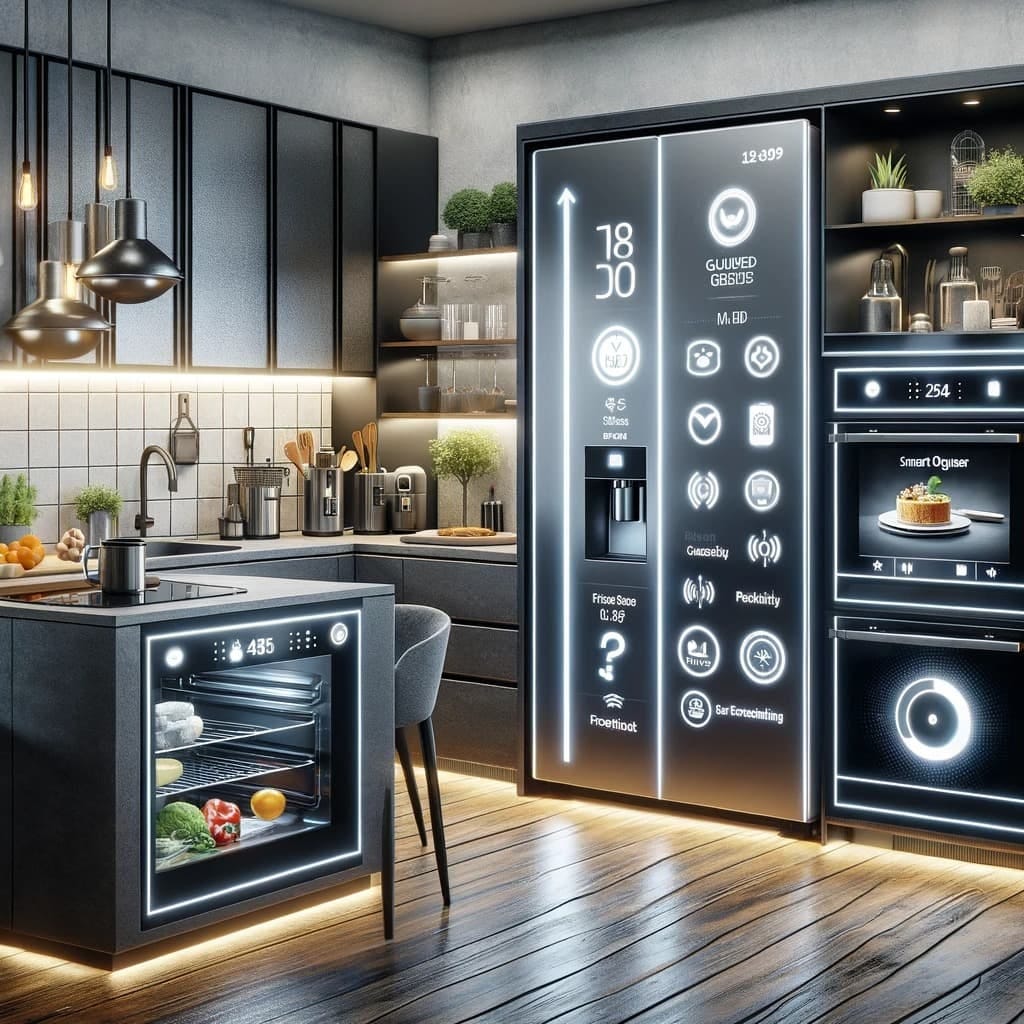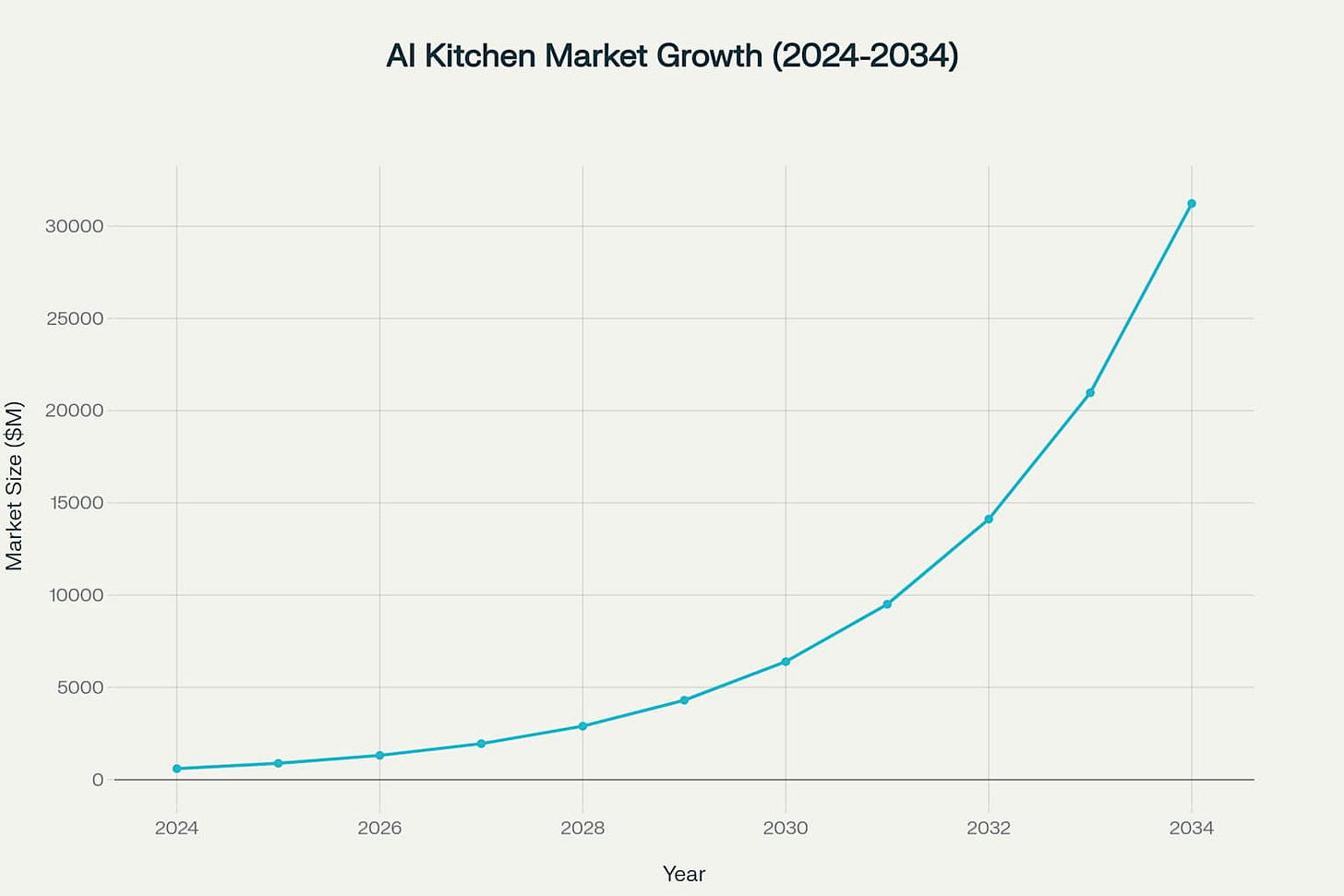The Rise of Artificial Intelligence in the Kitchen
Tech that’s Transforming How We Cook, Eat, and Live
Chef of the Future
The kitchen has always been the heart of the home, but today's culinary spaces are experiencing a technological upgrade that would have seemed like science fiction just a decade ago.
Artificial intelligence is quietly transforming our kitchens into intelligent, connected environments that not only assist with cooking but actively learn from our preferences, reduce food waste, and even anticipate our culinary needs before we do.
This transformation represents a fundamental shift toward more sustainable, efficient, and personalized cooking experiences that promise to revolutionize how we interact with food in our daily lives.
Table of Contents
🕖 TL;DR
🧊 The Smart Appliance Revolution
👨🍳 AI Recipe Generation and Meal Planning
🤖 The Emergence of Robotic Chefs
📈 Market Growth and Industry Adoption
💡 Benefits and Advantages
⚠️ Challenges and Limitations
🔮 The Future of Kitchen Technology
🏁 Final Thoughts
TL;DR
AI is transforming kitchens into smart, connected, and personalized environments.
Smart refrigerators track inventory, suggest recipes, and automate grocery lists to reduce waste.
AI-powered ovens auto-recognize food and adjust settings for precise cooking.
Recipe generation platforms create personalized meals based on preferences and ingredients, reducing food waste.
Robotic chefs can autonomously prepare thousands of dishes with professional precision, used increasingly in restaurants.
Market growth is rapid, projected from ~$600M (2024) to $31B (2034).
Key benefits include cooking precision, better nutrition management, and sustainability.
Challenges are high costs, privacy concerns, and limited adaptability.
Future trends: 3D food printing, predictive meal planning, and deeper smart home integration.
Bottom line: AI is making cooking more efficient, sustainable, and accessible.
The Smart Appliance Revolution

Intelligent Refrigerators Leading the Way
Smart refrigerators are the most visible AI manifestation in modern kitchens.
Samsung Family Hub:
Features large touchscreen displays as kitchen command centers.
Tracks food inventory in real-time using internal cameras.
Monitors expiration dates automatically.
Generates shopping lists based on consumption patterns.
Vision AI technology in modern refrigerators:
Identifies items inside the fridge.
Tracks when essentials like milk or eggs are running low.
Syncs with grocery delivery services (e.g., Instacart) for automatic replenishment.
Suggests recipes based on available ingredients to reduce food waste and discover new dishes.
GE Appliances SmartHQ platform:
Uses Google Cloud generative AI.
Allows users to take photos of fridge contents for tailored recipe suggestions.
Simplifies meal preparation through personalized recommendations.
AI-Powered Ovens and Cooking Precision
Smart ovens represent another major leap in kitchen AI technology.
Companies like GE Appliances, Siemens, Bosch, and Beko have introduced ovens with:
Computer vision cameras that recognize over 80 food types.
Automatic adjustment of cooking settings for optimal results.
Machine learning algorithms that improve cooking recommendations based on user feedback and outcomes.
GE’s SmartHQ app:
Uses generative AI features like Flavorly AI.
Creates customized recipes based on ingredients available in the kitchen.
Simplifies meal planning and reduces food waste by suggesting creative uses for ingredients before they expire.
Expanding the AI Kitchen Ecosystem
Beyond refrigerators and ovens, the AI-powered kitchen ecosystem includes:
June Intelligent Oven: A countertop convection oven using computer vision to identify foods and adjust settings automatically, with live video monitoring via app.
Brisk It Zelos 450 Smart Grill: An AI-enabled electric pellet smoker that leverages image recognition for recipe suggestions and adaptive cooking instructions.
Rotimatic: A fully automated roti and tortilla-making appliance that produces fresh flatbreads with machine learning precision.
Moley Robotic Kitchen: A high-end robotic kitchen with dual-arm manipulators capable of replicating chef-level recipes autonomously.
Anova Precision Sous-Vide: Wi-Fi and Bluetooth-enabled sous-vide immersion circulators ensuring precision temperature control with app integration.
LG ThinQ Appliances: A suite of AI-enhanced refrigerators, ovens, and dishwashers that learn user behavior to optimize performance and energy efficiency.
AI Recipe Generation and Meal Planning
Personalized Culinary Creativity
The emergence of AI-powered recipe generation platforms represents a paradigm shift in meal planning and culinary creativity. Services like DishGen, ChefBot, and Yummly AI use sophisticated algorithms to create personalized recipes based on available ingredients, dietary restrictions, and individual taste preferences. These platforms have collectively generated over one million unique recipes, demonstrating the vast potential for AI-driven culinary innovation.
The technology behind these systems combines natural language processing with extensive culinary databases to understand flavor profiles, cooking techniques, and nutritional requirements. Users can simply describe their dietary needs and available ingredients, and the AI generates complete recipes with cooking instructions, nutritional information, and even wine pairing suggestions.
Reducing Food Waste Through Intelligent Planning
One of the most significant benefits of AI recipe generation is its impact on food waste reduction. Traditional meal planning often results in unused ingredients and expired products, but AI systems can analyze entire pantries and suggest recipes that maximize ingredient utilization. Research indicates that families can save up to $1,500 annually by reducing food waste through intelligent meal planning and recipe suggestions.
The Emergence of Robotic Chefs
Autonomous Cooking Technology
The development of robotic chefs represents the most futuristic aspect of AI in the kitchen. Moley Robotics has created the world's first fully robotic kitchen, featuring articulated arms that can replicate the exact movements and techniques of professional chefs. These systems can cook over 5,000 different meals autonomously, from simple breakfast dishes to complex multi-course dinners.
The technology behind robotic chefs combines multiple sensory inputs including tactile, contact, and proximity sensors that allow the robots to handle ingredients with the same precision and care as human cooks. Advanced models can monitor more than 1,200 parameters every microsecond during the cooking process, ensuring consistent results and optimal food safety.
Commercial Applications and Restaurant Integration
Restaurant chains are increasingly adopting robotic cooking systems to address labor shortages and improve consistency. Companies like CubeSmart and Alfred by Dexai Robotics have developed specialized robots for salad preparation and egg cooking that can operate in commercial kitchen environments. These systems can prepare up to 40 portions per hour while maintaining precise portion control and food safety standards.
Market Growth and Industry Adoption
Explosive Market Expansion
The AI-enabled kitchen appliances market is experiencing unprecedented growth, with projections showing expansion from $594.8 million in 2024 to $31.2 billion by 2034, representing a compound annual growth rate of 48.6%. This explosive growth reflects increasing consumer demand for smart home technology and the growing recognition of AI's potential to transform daily cooking experiences.
North America currently leads global adoption with a 37% market share, driven by high disposable incomes and early acceptance of smart home technologies. The broader smart kitchen market, encompassing all connected appliances, is projected to reach $14.4 billion by 2030, indicating sustained momentum in kitchen technology innovation.
Driving Forces Behind Adoption
Several key factors are accelerating AI adoption in kitchens worldwide. The increasing number of single-person households and busy lifestyles create demand for time-saving cooking solutions. Additionally, rising environmental consciousness drives interest in technologies that reduce food waste and energy consumption. The COVID-19 pandemic further accelerated adoption as more people spent time cooking at home and invested in kitchen upgrades.
Benefits and Advantages
Enhanced Cooking Precision and Consistency
AI technology delivers unprecedented precision in cooking through real-time monitoring and automatic adjustments. Smart ovens can analyze food color, texture, and internal temperature to determine optimal cooking times and temperatures. This level of precision ensures consistent results regardless of the cook's experience level, effectively democratizing access to professional cooking techniques.
Improved Health and Nutrition
AI-powered kitchen systems can analyze the nutritional content of meals and provide personalized dietary recommendations based on individual health goals. Smart appliances can suggest ingredient substitutions for dietary restrictions and track caloric intake automatically. This technology proves particularly valuable for individuals managing diabetes, heart conditions, or other health issues that require careful dietary monitoring.
Environmental Impact and Sustainability
The environmental benefits of AI in kitchens extend beyond individual households to create broader sustainability impacts. Intelligent inventory management reduces food waste, while energy-efficient smart appliances optimize power consumption based on usage patterns. Studies suggest that widespread adoption of AI kitchen technology could significantly reduce the environmental footprint of home cooking.
Challenges and Limitations
Technical and Implementation Barriers
Despite rapid advancement, AI kitchen technology faces several significant challenges. High initial investment costs remain a primary barrier for many consumers, with advanced robotic systems costing tens of thousands of dollars. Technical limitations also persist, as current AI systems struggle with improvisation and adapting to unexpected situations that human cooks handle intuitively.
Privacy and Security Concerns
The increasing connectivity of kitchen appliances raises important privacy and security questions. Smart refrigerators and other connected devices collect extensive data about eating habits, shopping patterns, and household routines. Protecting this sensitive information from cyber threats requires robust security measures and ongoing vigilance from both manufacturers and consumers.
Limited Customization and Scalability
Current AI kitchen systems often provide limited customization options, particularly for users with specific dietary needs or cultural cooking preferences. Scaling these systems for different household sizes and cooking styles remains complex and expensive. Additionally, the learning curves associated with new technology can be steep for some users, requiring significant time investment to realize full benefits.
The Future of Kitchen Technology
Emerging Trends and Innovations
The future of AI in kitchens promises even more sophisticated integration and automation. Emerging trends include 3D food printing for personalized nutrition, advanced food recognition technology that can identify nutritional content through visual analysis, and multi-functional appliances that combine multiple cooking methods in single units. These innovations will likely make kitchens more compact while expanding their capabilities.
Integration with Smart Home Ecosystems
Future AI kitchen systems will achieve deeper integration with broader smart home ecosystems, enabling seamless coordination between kitchen appliances, home security systems, and personal digital assistants. This integration will create more intuitive and responsive cooking environments that anticipate user needs and automatically adjust to changing circumstances.

Predictive Capabilities and Machine Learning
Advanced machine learning algorithms will enable kitchen AI to become increasingly predictive, anticipating meal preferences, dietary needs, and shopping requirements based on historical patterns and external factors like weather, calendar events, and health data. This predictive capability will transform meal planning from a reactive process to a proactive system that anticipates and prepares for future needs.
Final Thoughts
The integration of artificial intelligence into kitchen technology represents a fundamental transformation in how we approach food preparation, meal planning, and culinary creativity. From smart refrigerators that manage our groceries to robotic chefs that can replicate professional cooking techniques, AI is making cooking more accessible, efficient, and enjoyable for millions of people worldwide.
Content was researched with assistance from advanced AI tools for data analysis and insight gathering. 








